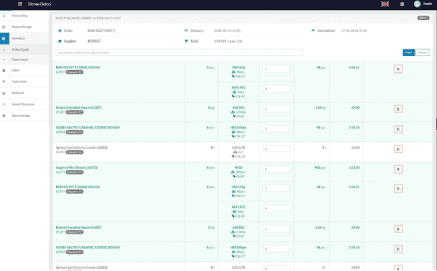The combination of a higher minimum wage and an increased tax burden is putting immense pressure on restaurant owners. According to the Centre for Policy Studies, 2025 looks set to be the most expensive ever for industries reliant on low-wage workers. Given such a gloomy outlook, many struggling F&B operators are expected to cut jobs. But staff turnover remains extremely high across the industry.
So, if you're getting by with a skeleton crew, you'll need to reduce restaurant costs elsewhere while trying to keep your existing team together. For many a cash-strapped owner, this is sobering prospect. Thankfully, Syrve can help in the following 8 problem areas.
1. Syrve Speeds Up Order and Payment Processing
Slow ordering and payment processing are major pain points for staff working front of house. Typically, these are caused by outmoded and complicated POS systems, order-routing delays, connectivity problems and limited payment options. During peak times, these issues can lead to acute frustration for front-line staff who’ve also got to contend with impatient customers.
To ensure a smooth front-of-house service at all times, Syrve features a fast, reliable and intuitive POS system. Specifically designed for quick ordering, its centralised dashboard enables staff to access menu information instantly, switch between order types and track the progress of each order as its being prepared in the kitchen.
.jpg?width=636&height=424&name=order-sources2(1).jpg)
To avoid staff bottlenecks, Syrve also features the Smart Order App for handheld POS devices. This allows servers to take orders and process payments tableside.
The centralised nature of Syrve’s POS also lends itself very well to operators running third party delivery services such as Uber Eats and Deliveroo. All external orders are injected into a single production pipeline, eliminating the need for additional hardware and dramatically simplifying front-of-house workflows. For put-upon cashiers and order-takers, this kind of functionality can be of enormous benefit.
2. Syrve Simplifies Stock Taking
Stocktaking is a necessary evil for those working in the food service industry. And while it may not be a chief contributor to high staff turnover per se, the process of counting every single item, from thyme to turnip, tends to dial up stress levels. It’s a tedious, time-consuming task made worse by the fact that checks often have to be conducted outside of normal hours.
With Syrve, this laborious task is simplified by guided stock checks that can be performed on mobile or tablet. Directing your staff to the correct storage area, the system presents a pre-filled list of items to be counted. On completion, your stock levels are then automatically adjusted.
3. Syrve Streamlines Kitchen Prep
The physical and mental intensity of working in a kitchen environment leads many employees to seek pastures new. Sometimes the pressure is just too great, particularly in restaurants struggling with operational problems. Often these are brought about by a host of inefficiencies, among them excessive food prep, inconsistent order flow and poor communication with front of house staff.
Syrve eliminates many of these problems with a combination of AI analysis, forecasting and automation. In terms of food prep, the system uses machine learning to evaluate historical sales data and provide forecasts with up to 98% accuracy. From this data, Syrve automatically generates streamlined prep and batch plans throughout the day. There's no need for chefs to worry about ingredient calculations or demand predictions - the system does everything for them. So, they've got more time to focus on cooking and creativity.

For smarter, more organised order management, Syrve’s KDS displays every order (both in-house and external) as it comes in - cooking time countdowns, status updates and dish-specific instruction allow chefs to prioritise dishes and make them to order. Everybody can monitor each stage of dish production including front-of-house staff. Chase-ups are therefore eliminated which reduces friction between front-of-house and kitchen. Servers can lowers their stress levels by keeping diners updated about their orders.
4. Syrve Empowers New Starters
A restaurant can be an intimidating environment for a new starter, whether they’re joining as a kitchen employee, order-taker or server. But there’s often little time for proper onboarding. More often than not, fresh recruits are expected to hit the ground running - this isn't easy for fresh faces if their new employer relies on a complicated POS system or runs a disorganised establishment.
To ensure a well-run ship, Syrve’s all-in-one platform integrates and automates all key processes, from front to back of house. At point of sale, new staff have access to intuitive POS terminals that are easy to master. In the kitchen, centralised recipe management and food prep data helps new hires to ensure dish quality and consistency, without the need of constant supervision.
5. Syrve Enables Smarter Staff Scheduling
At an operational level, a well-balanced rota ensures that you're never overstaffed or shorthanded. This is obviously critical. At the level of employee, it’s equally as important given the stresses associated with both scenarios.
For staff, the implications of understaffing are well-known. At front of house, servers struggle to keep up with orders leading to rushed service. Behind the stove, chefs are under more pressure to prepare dishes in less time. In both situations, mistakes become far more likely as does burnout and fatigue. Longer, more frequent hours also affect work-life balance, resulting in absenteeism and high staff turnover.
But overstaffing can be just as problematic. More servers on the floor means fewer tables per employee , resulting in less tips. This can breed frustration and resentment which often creates an unpleasant work environment. Staff who feel underutilised may also lose their sense of purpose and motivation.
.png?width=636&height=424&name=staff-schedule(1).png)
With Syrve, optimising rotas is a simple, transparent process that eliminates the errors and complexities of manual staff scheduling, while ensuring that you don't exceed your labour costs. Leveraging the system’s forecast data, the system's schedule planner allows you to pre-emptively create rotas to meet expected demand, weeks in advance. So you’ll never be blind-sided by events or other external factors.
Nor will you exceed your budget. The system adjusts your labour costs in real time, as you make changes to your schedules. It therefore becomes much easier to manage expenses.
6. Syrve Facilitates Open Communication and Engagement
Good communication is a core business principle, regardless of your chosen industry. But in the fast-paced, high-stress environment of a busy restaurant, there’s little time for open, two-way communication. Top-down interactions tend to be the norm between manager and employee with dialogue often based around instruction rather than verbal reciprocity.
To make matters worse, many operators fail to keep their employees in the loop regarding company updates or developments. In such scenarios, a general feeling of disengagement and underappreciation starts to erode team morale.
Syrve gets around this industry-wide problem in a simple, but very effective way. Each and every employee is allocated a personal page on the system which is accessible as soon as they log in. To engage staff, the page contains a live feed which can be updated with the latest company news, be it for an individual business or entire chain. This can be sent to staff via push notifications.
Each employee also has easy access to their rotas which helps to avoid last-minute scheduling disputes, and allows staff to plan their personal time around their shift patterns. The ability to establish a healthy work-life balance is of course essential for retention.
7. Syrve Features Goal Setting and Performance Monitoring Tools
Goal setting is another area of enormous importance. Without them, employees often go through the motions. As a result, motivation declines along with your revenue. Again though, busy managers often have little time to create goal-setting frameworks or to collect the data to monitor and reinforce the targets they've established. The only viable means of succeeding in this area is to rely on technology.
.png?width=636&height=424&name=champion(1).png)
Syrve can be of enormous help in this regard. Harnessing the power of AI, the system analyses all aspects of a restaurant’s operation, presenting actionable data about every key process. This also extends to employee performance.
With Syrve, it's possible to create leader-boards that ranks employees according to their sales performance. This includes a number of variables such as the number of items they’ve sold, the total revenue generated, total upsell value and their average customer spend. From this data, the system calculates an overall rating which it uses to rank staff, whether they’re cashiers, delivery operators or servers. All of this data can be monitored and analysed in Syrve's staff reporting suite.
The ability to provide clear, tangible goals will provide employees, particularly those working front-of-house, with a sense of purpose, improving their motivation and ultimately ensuring your business's success.
8. Syrve Reduces Payroll Errors and Ensures Transparency
Payroll management in the restaurant vertical is a complicated business, especially if you're trying to use manual processes. Factoring in irregular shift patterns, different wage structures and staff turnover is hard enough. Then there's labour law compliance to consider. Trying to manage all of these moving parts often leads to payroll errors and inconsistencies.
But in a sector where wages are generally low, many employees live from pay slip to pay slip, meaning that even the smallest mistakes can have serious financial consequences. Consistent, error free payroll processing is therefore essential for restaurant operators looking to foster a sense of trust and accountability. So too is transparency. Employees will want to understand how their wages, bonuses and tips are calculated. Hidden deductions or confusing pay structures won't help.
Using the accrual process, Syrve integrates its staff management and payment functionalities. The system automatically calculates employees' tentative wages according to the rotas which have been set up in the staff scheduler. With real-time labour cost data, managers are able to monitor staff expenses as they accumulate, so that they're able to respond to wage queries as and when they arise.
.png?width=636&height=424&name=staff-schedule4(1).png)
In addition, Syrve's comprehensive reporting suite provides a complete overview of all financial payroll obligations, meaning that any unexpected wage deductions or adjustments can be properly explained to staff.
To ensure compliance and accurate payments, Syrve also integrates seamlessly with a variety of established payroll systems including Xero. Eliminating the need for managers to manually export payroll data, these systems ensure that employee wages, including overtime, deductions and tips, are automatically transferred.
Learn more about how Syrve can help your business to keep a happy, motivated team: https://www.syrve.co




